Let me talk about my own experience of earning my second bucket of gold in the cryptocurrency space.
Graduated from university in 2018, worked in Shanghai, and entered the cryptocurrency space in early 2017.
Currently, I have a house and a car in Shanghai, with most of my assets on exchanges.
I originally worked in e-commerce in Shanghai, earning 20,000 to 30,000 a month, with monthly expenses over 10,000, saving about 10,000 to 20,000 each month.
However, with this income level, saving for a down payment would take an eternity, and there are bottlenecks in work income, making it hard for salaries to rise.
It wasn't until I got involved in the cryptocurrency space that I realized I could use the leverage of virtual currencies to multiply my assets! I put most of my savings into digital currencies, heavily buying ETH, along with a small amount of BTC and some miscellaneous altcoins.
I had several significant corrections along the way, increased my position, and then hardly made any trades. I didn't exit during the massive drop on May 19 and even increased my positions in some promising altcoins.
In November 2021, Bitcoin broke the historical high of 69,000 USD, and market sentiment was very high; many people thought it would break 100,000 USD, but actually, 69,000 was the peak of this bull market.
By the end of November, I saw the market trend weakening and inferred that the bull market was likely over, so I cleared most of my positions. At this time, Bitcoin was around 58,000, and Ethereum was around 4,400.
It has been proven that this is a very wise choice, while some retail investors with 'bullish fantasies', shouting 'eternal long bull', and clinging to 'tail-end trends' are now trapped.
After the bull market ended in 2021, my capital account had about 12 million RMB.
I took out 4 million to pay the down payment and bought a house in Shenzhen (after I graduated, I transferred my household registration to Shenzhen, and after three years of social security, I became eligible to buy a house), cashed out 2 million for daily use, and kept the remaining 6 million on exchanges, achieving financial freedom so far.
In the cryptocurrency market, profits depend on cycles; timing of entry, exit points, project selection, position allocation, and capital are all factors that will affect your profitability.
I have summarized the dumbest method of trading cryptocurrencies, allowing you to maintain 'eternal profit', make it 30 million!
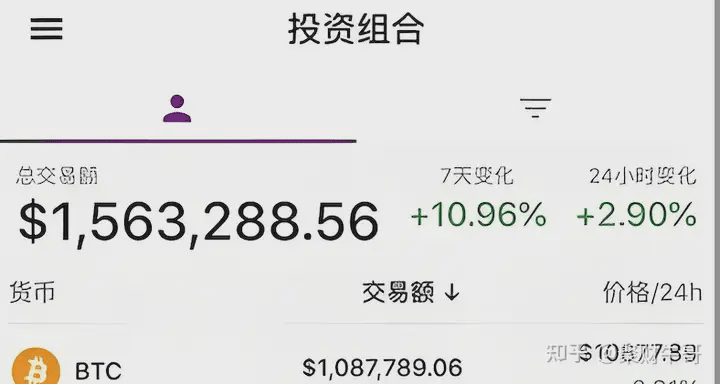



At the end of last year, I played with 200,000 and now have 20 million, easily achieving a hundred times profit (suitable for everyone). I still use this method, which is very stable.
You don't need to worry about whether you can learn this; if I can seize this opportunity, so can you. I'm not a god, just an ordinary person. The difference between others and me is that others overlook this method. If you can learn this method and pay attention to it during the subsequent trading process, it can help you earn an additional 3 to 10 percentage points of profit daily.
First step: Add cryptocurrencies that have increased in the last 11 days to your watchlist, but be careful to exclude any that have dropped for more than three days to avoid funds that have already exited for profit.
Step 2: Open the candlestick chart, looking only at the monthly MACD golden crosses.
Step 3: Open the daily candlestick chart, looking only at a 60 moving average. As long as the cryptocurrency price pulls back to the vicinity of the 60 moving average and a volume candle appears, then enter heavily.
Step 4: After entering the market, use the 60 moving average as a standard; if it is above the line, hold; if it is below the line, exit and sell. There are three details in total.
1. When the wave's increase exceeds 30, sell one-third.
2. When the wave's increase exceeds 50, sell one-third.
3. This is the most important and crucial factor determining whether you can profit. That is, if you buy in on the same day and unexpected circumstances arise, causing the price to break below the 60-day moving average the next day, you must exit entirely and not hold onto any illusions. Although the probability of breaking below the 60-day moving average is very small with this monthly line combined with daily line selection method, we must still have a risk awareness. In the cryptocurrency space, preserving capital is the most important thing. However, even if you have already sold, you can wait for it to meet the buying criteria again before buying back.
Ultimately, the difficulty in making money lies not in the method but in execution. 'If the price directly falls below the 60-day moving average, you must exit entirely and not hold onto any illusions.' Just this one sentence has killed 90% of the people.
Everyone's original intention for entering the cryptocurrency space is the same, and this is beyond doubt. If you come here just for fun, to pass the time, then this place is not suitable for you.
Here is a list I have organized of all the sectors and leading coins in the blockchain that you need to know before entering the cryptocurrency space, mainstream coins and altcoins.
Coins, saving you time on organization, which you can double-click to save!

How to quickly earn 1 million RMB in the cryptocurrency market! With just this one trick (BOLL indicator + Crocodile strategy), you can easily achieve a hundredfold profit, with a win rate as high as 90%. You're just one step away from 1 million, and it's worth saving!
BOLL (Bollinger Bands)
BOLL is a very simple and practical technical analysis indicator designed based on the principle of standard deviation in statistics by US stock analyst John Bollinger, and I personally believe it has great utility in the secondary trading of blockchain.
BOLL consists of three lines: upper, middle, and lower, also known as the upper band, middle band, and lower band.
The three lines of the Bollinger Bands represent resistance and support; when several reach the upper band, there will be a pullback due to resistance, and when reaching the lower band, there will be a rise due to support. When the stock price rises above the upper band, it indicates overbuying with the possibility of a pullback.
It also indicates that the stock is currently strong; conversely, when the stock price falls below the lower band of the Bollinger Bands, it indicates overselling, and the market is extremely weak. When the stock price drops from the upper band to the middle band, the middle band acts as a support level; if it breaks below the middle band, it becomes a resistance level. When the stock price rises from the lower band to the middle band, it also faces pressure. Breaking through the middle band and holding above it represents the transition from a resistance level to a support level.
Here are 10 golden basic rules for Bollinger Bands, which are very important:
1. Watch for price to break above the upper band for potential pullback. 2. Watch for price to break below the lower band for potential rebound. 3. Strong markets are always above the middle band.
4. Weak markets are always below the middle band. 5. The narrowing of the upper and lower bands hides volatility. 6. The larger the opening, the stronger the market momentum.
7. The middle band guides the trend direction. 8. A sudden narrowing of the channel indicates a reversal. 9. A sudden widening of the channel indicates consolidation is over.
10. The longer the channel narrows, the smaller the opening, the more significant and drastic the market changes will be.
Example explanation:
Taking BTC's 1-hour trend as an example, BOLL mainly consists of three lines: upper band, middle band, and lower band. When the price exceeds the upper band, it indicates overbuying, with a high probability of a pullback. When the price falls below the lower band, it indicates overselling, with a high probability of a rebound.
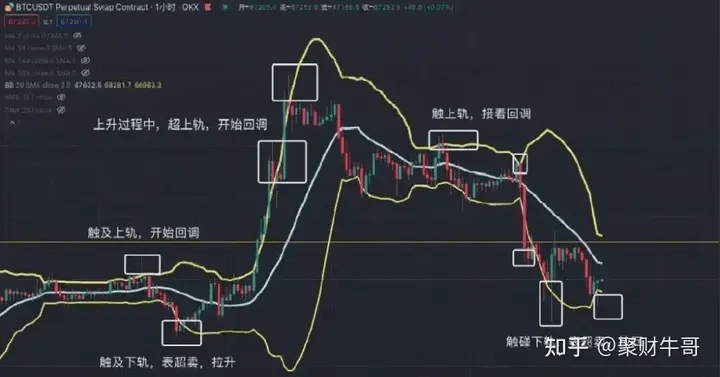
Continuing with the example of TRB's 1-hour trend, when the BOLL band narrows, it indicates that extreme market conditions are about to occur. However, BOLL cannot accurately determine the specific direction and requires other indicators for assistance. The longer the narrowing time, the shorter the BOLL band, indicating that future market conditions will be more intense. At the same time, in a strong upward market, BOLL will steadily rise along the middle band, while in an extremely strong market, BOLL will continuously rise above the upper band. Conversely, in a weak market, BOLL will decline along the middle band, at which point the middle band shifts from a support position to a resistance position. In an extremely weak market, BOLL will continuously fall below the lower band.
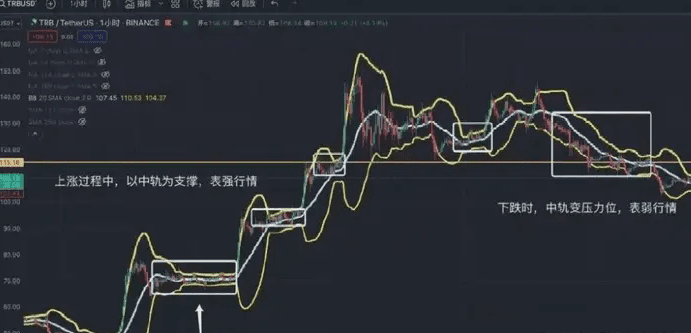
RSI (Relative Strength Index)
RSI (Relative Strength Index) works by calculating the magnitude of price changes to infer the strength of market trends, thereby predicting the continuation or reversal of trends. The RSI value fluctuates from 0 to 100, meaning the price will not exceed this range. We can simplify the understanding that when RSI reaches 70, it indicates overbuying, increasing the risk of a pullback, while when RSI falls below 30, it indicates overselling, which may lead to an increase.
Example explanation:
Taking BTC's 1-hour trend as an example, when RSI falls below 30, it indicates a need for sideways movement and a pullback, but this pullback is not absolute and only indicates a weak market condition, which cannot serve as a direct buying basis. Similarly, when RSI breaks above 70, it indicates overbuying and potential pullback risks. However, this still cannot serve as a buying or selling basis; it can only serve as auxiliary judgment. Note: In extreme market conditions, RSI can reach 99 or 1, so do not rely on RSI as the primary judgment criterion.
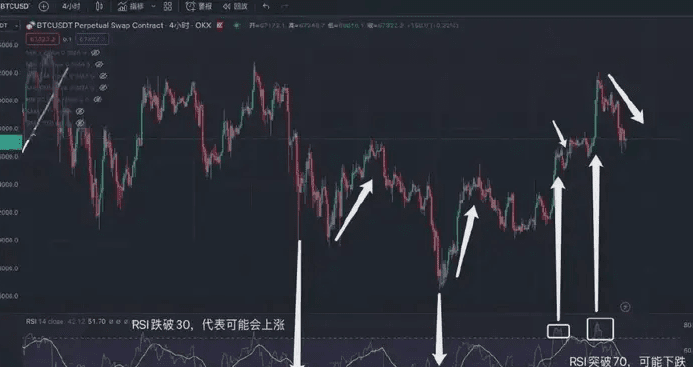
Continuing with the example of EDU's 4-hour trend, after RSI broke above 70, it continued to rise, and RSI ultimately reached 99. Therefore, we cannot use the method of buying at 30 and selling at 70. We need to assess the nature of stocks/cryptocurrencies, whether they are small-cap, MEME-type coins, or heavily controlled coins. Compared to blue-chip coins, the RSI judgment for other small coins may need to be elevated to the 90 and 10 range, rather than 30 and 70, which needs personal judgment.
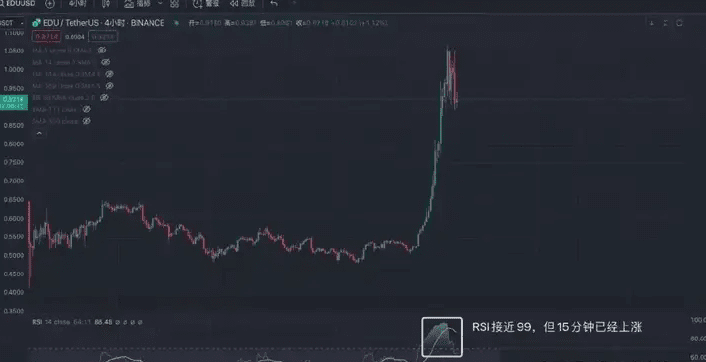
3. Flag pattern consolidation variation.
Flag pattern consolidation, also known as triangle consolidation, is not determined by indicators but by the changes in candlestick trends. We can summarize it into 16 common basic types of changes; if you see similar trends, you can buy in, generally with a high success rate, and expect a bullish trend afterward. However, there are also times of failure. It is advisable to buy at the low points of the flag, and when it breaks above the triangular area, that area becomes a support level. Later, if it declines, you can intervene near the support.
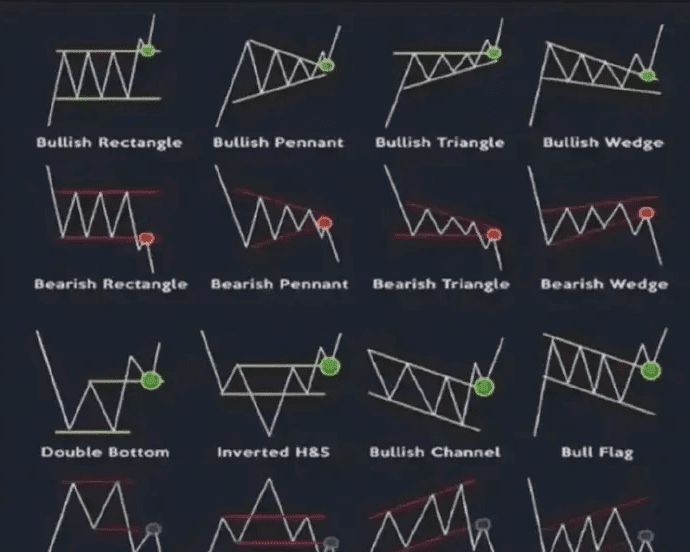
Example explanation:
Taking APT's 15-minute trend as an example, its trend perfectly replicated the third and tenth types shown above. However, it should be noted that this is just a successful case; many major players and institutions will deliberately create similar patterns to deceive traders. We need to be careful in distinguishing them or cutting losses in time.
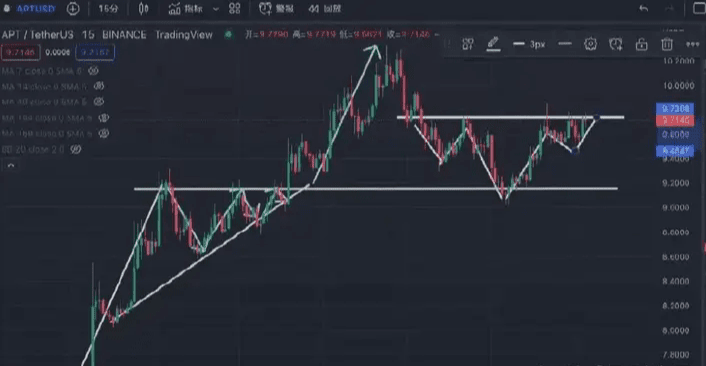
We take TRB's 1-hour trend as an example; we observed that TRB utilized a three-week flag pattern, resulting in a threefold increase in a week. Therefore, when we see similar trends in the market again, we can draw them ourselves for validation.
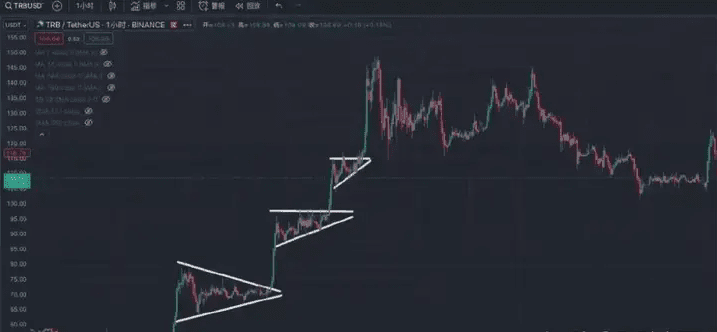
Knowing is not difficult, but acting is not easy. For investments in the secondary market, everyone knows not to be greedy and not to chase highs and kill lows, but how many people can control their hands to achieve unity of knowledge and action? In the Tao Te Ching, Laozi mentions Dao, Fa, and Shu. Dao refers to rules, natural laws, and core ideas; Fa refers to methods, legal principles, and systems; while Shu refers to actions and operational methods. The combination of Dao, Fa, and Shu is regarded as an important principle and guideline for guiding people's lives and social development.
For the secondary market, we can also divide investments into Dao, Fa, and Shu, and none of the three can be lacking.
Dao: Represents investment philosophy and faith, which includes the direction, goals, and values of investment, along with analysis of long-term market trends, macro conditions, and fundamentals.
Fa: Represents the rules and principles of investment, including investment strategies, risk management, and asset allocation.
Shu: Represents the technical analysis of investments, quantitative analysis, and trading psychology.
Today's report will focus on the 'Shu' in trading, aiming to share the application of technical indicators and technical analysis in practice. For the vast majority of people, there is no need to learn many obscure technical indicators because they are lagging and do not lead directly to profit. This report will share commonly used technical indicator methods to let more people understand the significance of technical analysis.
The 'Crocodile Principle' - the trading rules of the greatest traders, a useful and simple trading rule - 'Crocodile Principle'.
This principle originates from the way crocodiles consume their prey: the more the prey struggles, the more the crocodile gains. Suppose a crocodile bites your foot; if you try to break free with your arm, it will simultaneously bite both your foot and your arm. The more you struggle, the deeper you become trapped.
So, if a crocodile bites your foot, remember: your only chance for survival is to sacrifice one foot.
The Crocodile strategy is as follows:
1. Do your utmost to put aside idle money that won't be needed for a year.
2. Strictly select valuable coins and make good capital allocation plans;
3. Build positions in batches; no all-in! No all-in! No all-in!
4. Take action according to the situation; in special market conditions, you must reduce positions or even go to cash.
5. Long-term to prevent missing out, mid-term for profit-taking, short-term for small gains.
6. Strictly follow the 'Crocodile 4321' strategy.
Crocodile 4321 strategy practical application.
1.4: At least keep 40% of the total funds for dollar-cost averaging into long-term cryptocurrencies. The specific averaging method is: for each 10% decline in a long-term cryptocurrency, average 10% of the total allocated funds for that cryptocurrency (for example: if planning to invest 400,000 in BTC, after initially buying 120,000, average 40,000 each time it falls 10%).
2.3: Use 30% of total funds to allocate to long-term value coins; under normal circumstances, only average down, do not sell at a loss (for example: planning total investment of 1 million, 400,000 in BTC, 300,000 in ETH, 300,000 in BNB, initially actually allocated 300,000, with BTC 120,000, ETH 90,000, BNB 90,000);
3.2: Use 20% of the funds to position in medium to long-term valuable coins, with profit-taking and stop-loss around 20%;
4.1: Use 10% of the funds for short-term trading, entering and exiting quickly, with profit-taking and stop-loss around 5%-10%. Knowing the overall allocation plan of the total funds should make you feel more secure, right? But is there a trading strategy? Indeed, there is!
This is the phased 343 position-building method:
Having determined the coins I am ready to invest in, cash is also prepared. For example, in the previous actual allocation of 300,000, BTC is allocated 120,000.
1.3: Use 30% of the current funds to build a position, which is 36,000 (12 multiplied by 0.3) for the initial position.
2.4: If the price starts to rise after building a position, wait for the price to pull back before averaging, using 40% of the current funds to average down (any rise will have a pullback). If the market does poorly after building a position and starts to fall, every time BTC falls by 10%, average 10% of the remaining funds (36,000), until it is fully averaged. This situation is rare; of course, even if it happens, do not be afraid, as it is a phased building of positions; your price has been averaged down (and there is still 40% of the total funds left to average, referring to the 4 in the 4321 strategy).
3. If the price starts to rise after averaging down, wait for the price to pull back again before averaging down, using 30% of the current funds to average down, completing the phased position building.
Overcome fear and control greed!!! You can't think about buying at the lowest point and selling at the highest point; we need a scientific investment strategy!!! Always thinking about buying at the lowest point is fear, because there is no lowest—only lower points, and this will prevent you from entering. Always wanting to sell at the highest point will only lead to being stuck, because in your mind, there is no highest point. Your mind is occupied by greed!!!
In the world of cryptocurrencies, every notable tenfold increase begins with an unremarkable journey to double. This article will reveal a practical strategy from identifying little calves to patiently waiting, ultimately capturing major bull cryptocurrencies.
1. A discerning eye: Finding the traces of little calves.
1. Recently strong performance.
First, focus on cryptocurrencies that have increased by over 100% in the last two months. These 'little calves' often indicate stronger potential, as they have already shown high recognition and popularity in the market. Remember, the logic that the strong get stronger also applies in the cryptocurrency market.
2. Innovating highs and maturity.
Further filter projects whose prices have reached an all-time high and have been online for more than six months. An all-time high is a direct reflection of market confidence, while long-term operations indicate a certain level of maturity and stability for the project. Don’t miss opportunities because of worrying that 'prices are too high', because any major bull coin's rise starts from doubling.
2. Patiently waiting: The art of intermediate adjustments.
Definition of intermediate adjustments.
Intermediate adjustments are the process of the market naturally cooling down and the turnover of chips, usually manifested as long periods of oscillation or pullback, lasting at least two months or more. This process is crucial for the healthy development of the market, as it allows excited funds to cool down while enabling chips with large profits to turnover in the market, thus bringing the average cost closer for all participants.
The significance of adjustments.
Patiently waiting for intermediate adjustments is to allow the internal forces of the market to become more balanced, accumulating strength for subsequent rises. For particularly strong cryptocurrencies, the adjustment time may be relatively short, but even so, attention should be paid to whether it has genuinely completed the necessary turnover and rest.
3. Precise entry: Dual resonance of indexes and sectors.
Choosing the timing to enter the market.
Just because the adjustment time meets the requirements doesn't mean you can blindly enter the market. It is more important to observe the trends of the market and sectors and wait for resonance signals to appear between them.
Two key signals.
Volume expansion in a long bullish candle: When a cryptocurrency breaks through an important resistance level after a correction in the form of a long bullish candle with increased volume, it is often a signal for the start of a new upward trend.
Narrow-range fluctuations with reduced volume: Another possible entry timing is during the end of a correction, where the price fluctuates in a narrow range under reduced volume, which often indicates that the market is about to choose a direction, with a higher probability of breaking upward.
Seizing opportunities.
Do not wait until the cryptocurrency price surpasses the pre-correction high point to enter the market, as you might have already missed the best buying opportunity. By observing the signals mentioned above, you can seize the opportunity near the launch point and occupy a more favorable position.
Conclusion
Capturing major bull cryptocurrencies is not easy; it requires us to possess keen market insight, the ability to wait patiently, and precise operational skills. By identifying little calves, patiently waiting for intermediate adjustments, and precisely grasping entry timing, we can find our own path to wealth in this opportunity-filled yet challenging cryptocurrency market.
When the market starts, profits double. Cheng Ge will guide you to follow the trend, and wealth will naturally come!
Continuously monitor: SPK, C.